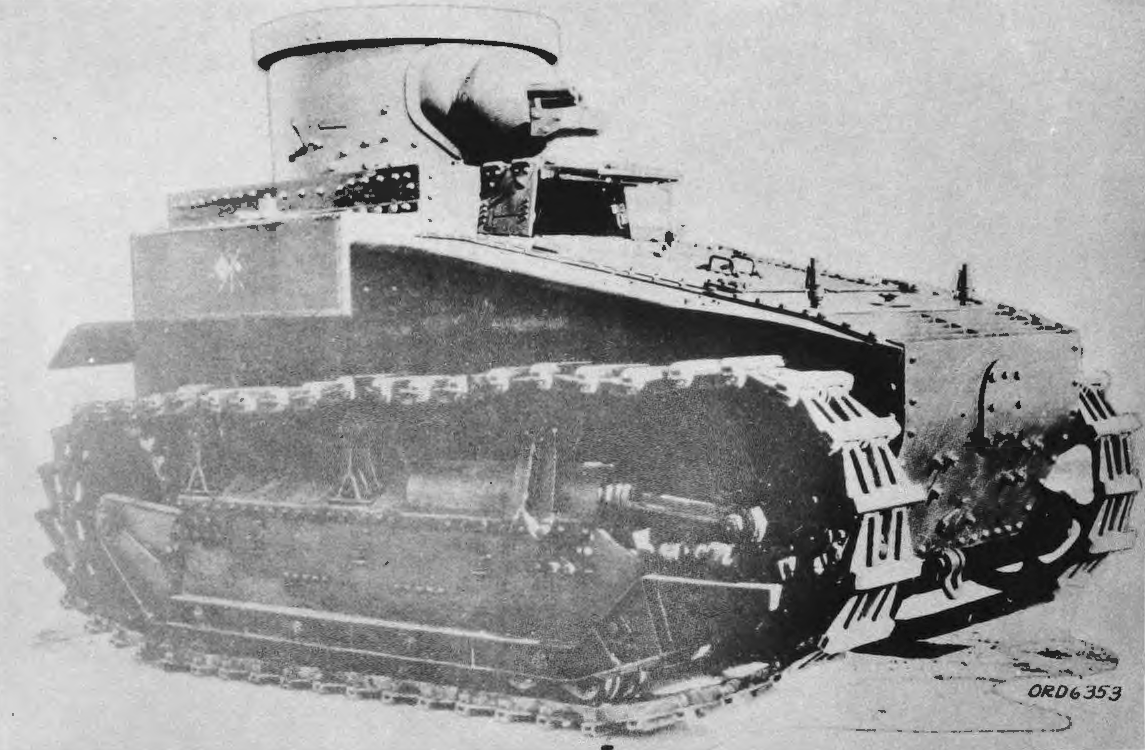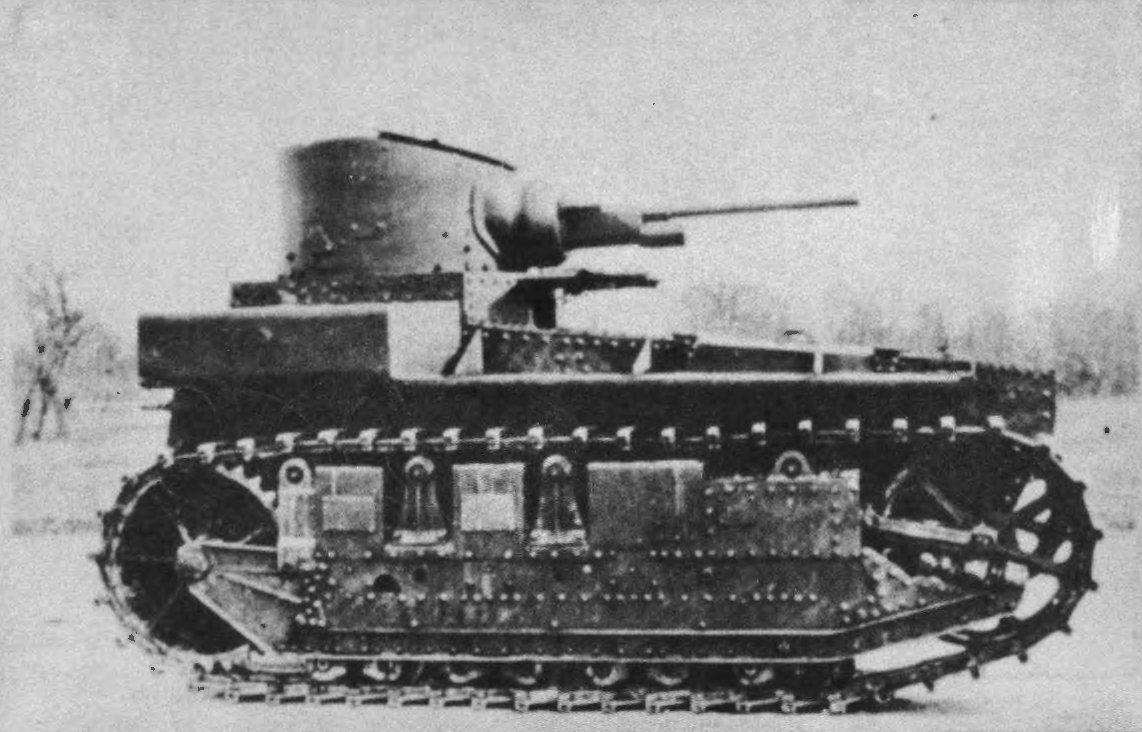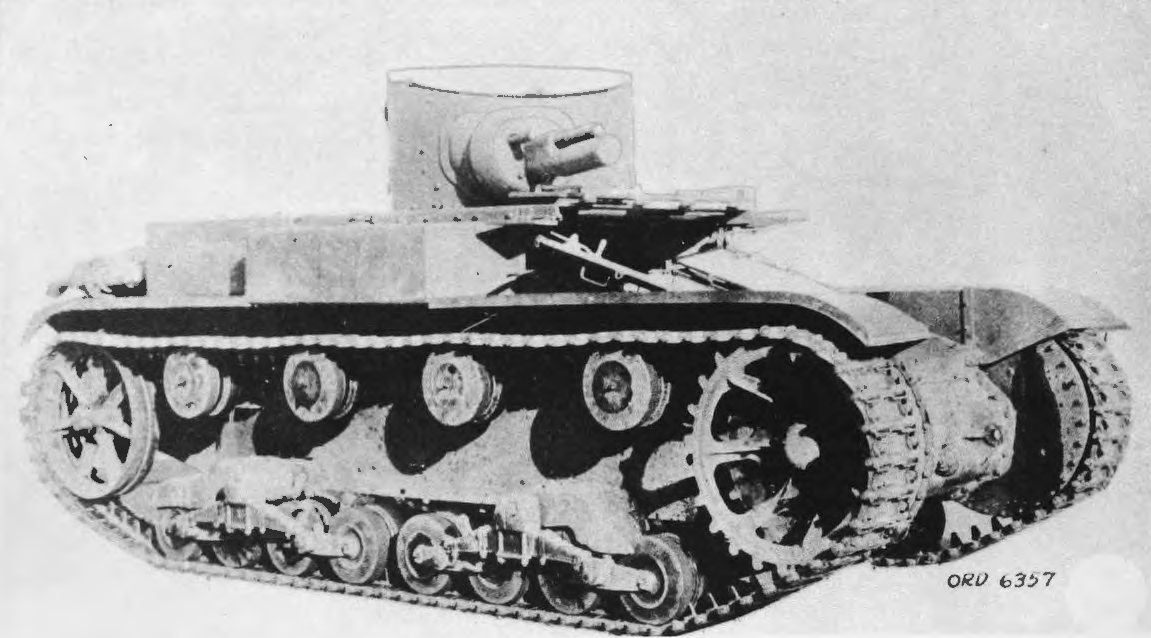T1 Light Tank on:
[Wikipedia]
[Google]
[Amazon]
The Light Tank, T1 was a





 Most versions of the T1 series of light tanks shared the same basic layout, with the engine mounted in the front and the turret, transmission and final drive all located in the rear. The exceptions were the T1E4 and T1E6, which moved the turret to the middle, the engine to the rear, and the transmission and final drive to the front, a configuration similar to later tanks. All T1 versions had a manually traversed turret armed with a 37 mm () main gun and a coaxially mounted
Most versions of the T1 series of light tanks shared the same basic layout, with the engine mounted in the front and the turret, transmission and final drive all located in the rear. The exceptions were the T1E4 and T1E6, which moved the turret to the middle, the engine to the rear, and the transmission and final drive to the front, a configuration similar to later tanks. All T1 versions had a manually traversed turret armed with a 37 mm () main gun and a coaxially mounted
Light Tank M1
at AFV Database {{Use dmy dates, date=June 2017 Interwar tanks of the United States Light tanks of the United States Trial and research tanks of the United States Light tanks of the interwar period
United States Army
The United States Army (USA) is the land warfare, land military branch, service branch of the United States Armed Forces. It is one of the eight Uniformed services of the United States, U.S. uniformed services, and is designated as the Army o ...
light tank of the late 1920s and early 1930s that was only built in prototype form. The tank was an Army design built by James Cunningham, Son and Company
James Cunningham, Son and Company was an American business based in Rochester, New York, initially manufacturing horse-drawn coaches, that from 1908 onward developed and produced automobiles. The Cunningham company was a pioneer in automobile prod ...
. Introduced in 1927, it was developed up through 1932 as a series of modified versions (T1E1, T1E2, T1E3, T1E4, T1E5, and T1E6). The tank was never mass-produced, nor was it ever used in combat.
Design and variants





 Most versions of the T1 series of light tanks shared the same basic layout, with the engine mounted in the front and the turret, transmission and final drive all located in the rear. The exceptions were the T1E4 and T1E6, which moved the turret to the middle, the engine to the rear, and the transmission and final drive to the front, a configuration similar to later tanks. All T1 versions had a manually traversed turret armed with a 37 mm () main gun and a coaxially mounted
Most versions of the T1 series of light tanks shared the same basic layout, with the engine mounted in the front and the turret, transmission and final drive all located in the rear. The exceptions were the T1E4 and T1E6, which moved the turret to the middle, the engine to the rear, and the transmission and final drive to the front, a configuration similar to later tanks. All T1 versions had a manually traversed turret armed with a 37 mm () main gun and a coaxially mounted .30 caliber
The 7.62 mm caliber is a nominal caliber used for a number of different cartridges. Historically, this class of cartridge was commonly known as .30 caliber, the imperial unit and customary unit equivalent, and was most commonly used for i ...
(7.62 mm) M1919 Browning machine gun
The M1919 Browning is a .30 caliber medium machine gun that was widely used during the 20th century, especially during World War II, the Korean War, and the Vietnam War. The M1919 saw service as a light infantry, coaxial, mounted, aircraft, and ...
, and all carried a crew of two: a commander who sat within the turret and worked the guns, and a driver seated just in front of the turret.
The single T1 prototype was built in 1927. Its main gun was a 37 mm M1918 short tank gun, a U.S. version of a French infantry support gun
Infantry support guns or battalion guns are artillery weapons designed and used to increase the firepower of the infantry units they are intrinsic to, offering immediate tactical response to the needs of the unit's commanding officer. They typicall ...
of World War I. This was a relatively low-velocity weapon, with a muzzle velocity of . The tank's armor ranged from to in thickness, and the tank's overall weight was . It was powered by a Cunningham water-cooled V8 gasoline engine which gave it a top speed of . The transmission, made by Cotta, was a sliding-gear type with three forward gears and one reverse gear. After the prototype was evaluated, it was stripped down to its chassis, which was reused to test other vehicle types.
The T1 prototype was followed in 1928 by the very similar T1E1. Four of these were built, making the T1E1 the only T1 version which was not built as a single prototype. The T1E1 was briefly standardized for production as the Light Tank, M1, but this was revoked after only a couple of months. The T1E1 had a few minor changes from the T1: the hull no longer projected forward of the tracks, and the fuel tanks were moved above the tracks. The top speed was reduced to .Jones et al., page 164
The next version, the T1E2, was built in 1929, again as a single prototype. It had heavier armor, varying from to thick, and the tank's weight rose to . The Cunningham V8 engine had its power boosted to , giving the T1E2 a slightly higher power-to-weight ratio than its predecessors; despite this, the maximum speed was only because of changes in the gear ratios. The 37 mm main gun was changed to a long-barreled Browning semi-automatic type, having a much higher muzzle velocity of , though later the old M1918 model was reinstalled.
In 1930 the Ordnance Department
The United States Army Ordnance Corps, formerly the United States Army Ordnance Department, is a sustainment branch of the United States Army, headquartered at Fort Lee, Virginia. The broad mission of the Ordnance Corps is to supply Army comb ...
modified one of the T1E1 tanks to create the T1E3. In some ways this was a hybrid of the T1E1 and T1E2; it had the high-velocity long-barreled Browning gun, thickened armor, and more powerful engine of the T1E2, but it retained the hull, turret, dimensions, and transmission gear ratios of the T1E1. The T1E3 weighed . Since it had the T1E2's more powerful engine and the T1E1 gearing, this gave it both a higher power-to-weight ratio and greater speed than any previous T1 version, with a maximum speed of . The most important feature of this version, however, was its suspension, which was completely redesigned. All previous T1 versions had a totally unsprung suspension which used multiple equalizing links between the bogies to spread out impacts from rough terrain. This still gave a very rough ride. The T1E3's suspension had coil spring
A selection of conical coil springs
The most common type of spring is the coil spring, which is made out of a long piece of metal that is wound around itself.
Coil springs were in use in Roman times, evidence of this can be found in bronze Fib ...
s and hydraulic shock absorbers, and its ride was much smoother.
The T1E4, introduced in 1932, was another alteration of a T1E1 tank. Its transformation was much more radical, however, because the vehicle's layout was completely changed. The engine was moved to the rear, the transmission and final drive to the front, and the turret to the middle of the body. At in length, the T1E4 was nearly a quarter again as long as preceding T1 versions. The T1E4 also got a new suspension, in this case using semi-elliptic leaf spring
A leaf spring is a simple form of spring commonly used for the suspension in wheeled vehicles. Originally called a ''laminated'' or ''carriage spring'', and sometimes referred to as a semi-elliptical spring, elliptical spring, or cart spring, i ...
s and articulated four-wheel bogies. (This suspension was similar to that of the British Vickers 6-Ton
The Vickers 6-ton tank or Vickers Mark E, also known as the "Six-tonner" was a British light tank designed as a private project at Vickers. It was not adopted by the British Army, but was picked up by many foreign armed forces. It was licen ...
light tank, which the Army had recently tested.) The main gun was replaced by the 37 mm semi-automatic gun M1924, whose muzzle velocity of was lower than that of the long-barreled Browning in the T1E2 and T1E3. The armor thickness was similar to the T1E2 and T1E3. The T1E4 had an overall weight of . At first the T1E4 retained the engine from the T1E1, but this proved to be underpowered, so it was replaced by an improved Cunningham V8 producing , giving the T1E4 a top speed of .
The T1E5, introduced around the same time as the T1E4, was yet another conversion of a T1E1, in this case with a new steering system. All previous T1 versions used a simple clutch-brake steering system which led to a loss of power while turning. The T1E5 replaced this with a controlled differential steering system from the Cleveland Tractor Company (a so-called "Cletrac" system). The engine was also replaced with the same version as in the T1E4. Testing showed the controlled differential steering to be clearly superior to the clutch-brake system, and the Ordnance Department recommended its use for all tracked vehicles that could exceed .
The final T1 version produced, the T1E6, was introduced in 1932 as a further alteration of the T1E4. The Cunnigham V8 engine was replaced with a V12 V12 or V-12 may refer to:
Aircraft
* Mil V-12, a Soviet heavy lift helicopter
* Pilatus OV-12, a planned American military utility aircraft
* Rockwell XFV-12, an American experimental aircraft project
* Škoda-Kauba V12, a Czechoslovak experim ...
made by the American-LaFrance and Foamite Corporation. Even though the tank's weight increased to , its more powerful engine gave it the best power-to-weight ratio of the entire T1 series. However, the maximum speed was still , and the larger V12 engine severely crowded the engine bay, making maintenance troublesome. The T1E6 kept the armament of the T1E4; the armor's maximum thickness remained unchanged, but the minimum thickness increased from to .
Preservation
The T1E2 has been preserved, though without its guns. Previously it was on outdoor display at the U.S. Army Ordnance Museum atAberdeen Proving Ground
Aberdeen Proving Ground (APG) (sometimes erroneously called Aberdeen Proving ''Grounds'') is a U.S. Army facility located adjacent to Aberdeen, Harford County, Maryland, United States. More than 7,500 civilians and 5,000 military personnel work a ...
in Aberdeen
Aberdeen (; sco, Aiberdeen ; gd, Obar Dheathain ; la, Aberdonia) is a city in North East Scotland, and is the third most populous city in the country. Aberdeen is one of Scotland's 32 local government council areas (as Aberdeen City), and ...
, Maryland. Due to that museum's closure in 2010, it has been moved to the U.S. Army Ordnance Training and Heritage Center
The United States Army Ordnance Training Support Facility (formerly known as the U.S. Army Ordnance Training and Heritage Center and U.S. Army Ordnance Museum) artifacts are used to train and educate logistic soldiers. It re-located to Fort Lee ( ...
at Fort Lee, Virginia, where it is presently in indoor storage and not publicly accessible.
References
Sources
* * *External links
Light Tank M1
at AFV Database {{Use dmy dates, date=June 2017 Interwar tanks of the United States Light tanks of the United States Trial and research tanks of the United States Light tanks of the interwar period